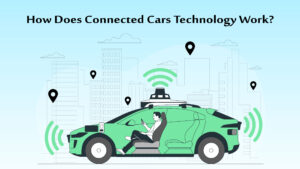An increasing number of users want their connected vehicles to act as Wi-Fi hotspots, aiming for seamless internet connectivity on the go. This turns the car into an extension of their homes or offices.
This surge in demand is exemplified by the fact that the number of connected cars surpassed 125 million in 2022, marking a 270% surge from 2018. But what defines connected cars, and what advantages do they offer? Furthermore, how does one access in-car Wi-Fi, commonly referred to as a car hotspot? Let’s delve into the details.
What are Connected Cars?
Any vehicle that has wireless network communication capabilities with other cars, the internet, and road infrastructure is referred to as a connected car. A car hotspot can be accessed by passengers in a connected vehicle as well. Passengers can then use this hotspot to connect several devices, just like they would at home, to the internet.
In today’s world, smart vehicles play a crucial role in enabling communication between each other (V2V) using the dedicated short-range communication spectrum (DSRC) managed by the public or federal authorities. Additionally, they can communicate with smart city infrastructure (V2I) using cellular-based communication technology (C-V2X) or protocols based on machine-to-machine or the Internet of Things. These advanced vehicles are a significant element in the evolving connected landscape, and it is expected that customers will increasingly demand such connected functionalities in the future.
How Does Connected Cars Technology Work?

A connected car is any vehicle that has internet connectivity installed. Nowadays, embedded and tethered systems are the two types of systems used by automakers in connected cars. A tethered system will have hardware that connects to the driver’s smartphone, while an embedded car will have a chipset and integrated antenna.
A connected car may receive and send data, download software updates and patches, establish connections with other Internet of Things (IoT) devices, and offer WiFi or internet access to its occupants. Another thing accessible through connected technology is connected auto telematics, which is quite helpful for electric vehicles.
Connected Cars: What Advantages Await You on the Road?
The primary advantages of connected cars include the reduction of accidents and the preservation of human life, cost savings, and environmental protection. Over time, there has been significant progress in life-saving technologies such as e-Call roadside emergency systems and the Emergency Crash Warning System.
Based on the report titled “Sustainable Mobility of the Future and its Impact on the SDGs” hosted by Mobility City, it is projected that there will be over 500 million interconnected vehicles operating globally by the year 2025. This advancement could potentially result in approximately 11,000 lives being saved and a reduction of 400,000 tons in annual CO2 emissions.
Furthermore, sustainability can be enhanced through the exchange of data. By providing drivers with information about their driving habits, they can improve their behavior behind the wheel and make conscious efforts to avoid traffic congestion. Moreover, cities can play a crucial role in promoting sustainable mobility by integrating various modes of transportation. For instance, access to real-time information about available parking spaces or bus schedules can significantly contribute to reducing CO2 emissions from vehicles. Additionally, this approach fosters optimized mobility, which benefits sectors like logistics, by creating a positive impact.
What Lies Beneath the Surface of ‘Connected Cars’ in the Automotive World?

Provide Entertainment and Control Features
Today, individuals can utilize their connectivity to seamlessly connect their mobile devices to the multimedia features of an automobile. Prominent examples of this are Apple Carplay and Android Auto, which allow users to utilize the vehicle’s integrated display to stream music, receive navigation guidance, and engage in text messaging and phone calls, all using a familiar interface similar to that of their mobile phones.
Alexa, the smart device developed by Amazon, is another example of the seamless integration between technology and households. By establishing a connection with various home devices like heating systems and lighting fixtures, Alexa allows users to control these components effortlessly from the comfort of their driver’s seat.
Likewise, when at home, individuals can utilize Alexa to operate their car’s onboard systems, including locking mechanisms, heating functionalities, and even camera access. The convenience is increased further as all these actions can be executed through simple voice commands. For instance, one can effortlessly search for a destination while lounging on the sofa, and the directions will be seamlessly transferred to their vehicle once they step inside.
Help Improve Road Safety
Connected cars can establish a connection as a collective unit through V2V technology, without the need for physical attachment. This advancement offers numerous advantages, including enhanced fuel efficiency and the capability for faster driving, as each vehicle is aware of the status of other vehicles.
Innovative advancements in technology have made it possible to anticipate and avoid red lights, thereby reducing fuel consumption, alleviating traffic congestion, and minimizing the risk of accidents. Additionally, drivers can receive real-time information about available parking spaces, enabling them to quickly locate vacant spots without aimlessly circling around and wasting precious time.
What’s Next for Connected Cars?
Connected car technology is not restricted solely to traditional cars. It will also be employed by autonomous vehicles to establish communication with both the road infrastructure and the cloud system. As the market continues to witness the introduction of more connected car solutions, consumers are increasingly inclined toward adopting connected cars. In the foreseeable future, connected technology will become the standard, contributing to improved safety measures and a reduction in accidents. The emerging 5G connectivity will further enhance this technology, making connected vehicles smarter and user-friendlier.




